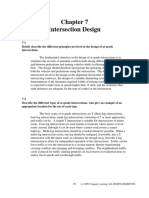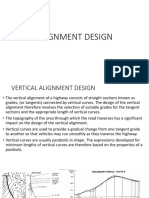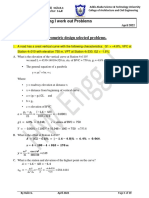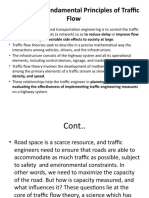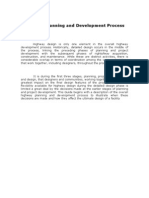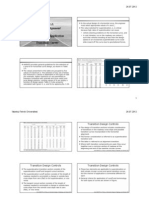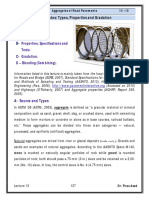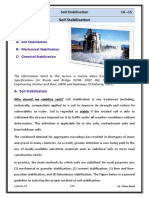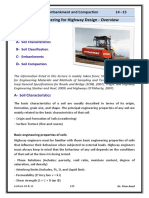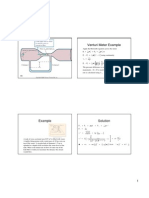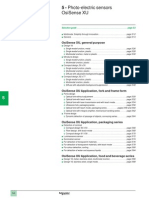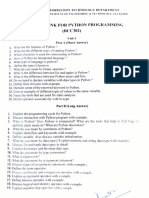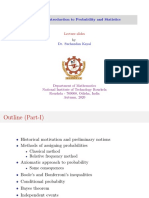Lec 05 Highway Engineering - Curve Superelevation
Lec 05 Highway Engineering - Curve Superelevation
Uploaded by
Dr Firas AsadCopyright:
Available Formats
Lec 05 Highway Engineering - Curve Superelevation
Lec 05 Highway Engineering - Curve Superelevation
Uploaded by
Dr Firas AsadOriginal Description:
Copyright
Available Formats
Share this document
Did you find this document useful?
Is this content inappropriate?
Copyright:
Available Formats
Lec 05 Highway Engineering - Curve Superelevation
Lec 05 Highway Engineering - Curve Superelevation
Uploaded by
Dr Firas AsadCopyright:
Available Formats
Highway Eng.
Superelevation
14 15
Superelevation at Horizontal Curves
In this lecture;
--------------------A- Definition and Justifications.
B- Min. Radius of Circular Curve.
C- Superelevation Section (Runoff
& Runout).
D- Superelevation Attainment .
The information listed in this lecture is mainly taken from the Policy on Geometric Design of
Highways and Streets (AASHTO, 2011), Iraqi Highway Design Manual (SORB, 2005) and
Traffic and Highway Engineering (Garber and Hoel, 2009).
A- Superelevation: Definition and Justification
Superelevation is the banking ()
of
roadway
around
curves
to
counterbalance the centripetal force
of a vehicle traversing a
horizontal curve.
The provision of superelevation - one edge of
a roadway higher than the other - will
prevent vehicles from overturning or sliding
off the road. The side friction between
pavement
and
tires
also
help
in
counterbalancing the centripetal (outward
pull) force.
Lecture 05
46
Dr. Firas Asad
Highway Eng.
Superelevation
14 15
There are limitations for values of highways cross slopes. The minimum rate of
cross slope applicable to the travelled way is determined by drainage needs. In
contrast, the maximum amount of superelevation should not be exceeded for
preventing slow-moving vehicle from sliding or overturning to the inside of the
curve when the road is covered with rain, snow, or ice.
According to AASHTO, the minimum rate of cross slope, also called normal crown is
(1.5 2)% while the maximum amount of superelevation is (10 12)%.
B. Minimum Radius of Circular Curve
When a vehicle is moving around a circular
curve the centripetal force will attempt to pull
the vehicle outside the curve. In flat curves
(with large radii) this force can be fully
counterbalanced
by
the
side
friction.
However, for sharper curves, only side friction
will not be enough to prevent vehicles from
sliding outwards and hence superelevation is
needed.
The minimum radius of a circular curve R for a
vehicle travelling at V kph can be determined
by considering the equilibrium of the vehicle
with respect to its moving up or down the
incline. If is the angle of inclination of the
highway, the component of the weight down
the incline is W sin , and the frictional force
also acting down the incline is . W cos .
Lecture 05
47
Dr. Firas Asad
Highway Eng.
Superelevation
14 15
2
Where is the coefficient of side friction. The centrifugal force is W . V .
Other forces acting on the car are its weight W and force exerted against the wheel
by the roadway surface. These forces are the normal force N, and friction forces F,
so: F N. Appling equilibrium by algebraic summing for forces parallel to the
roadway gives:
cos (
W V2
.
) = F + W sin
g R
N = W cos + sin (
; since F = N and
W V2
.
)
g R
But, superelevation e = tan . ------ >
V2
V2
W V2
W V2
cos ( .
) = f ( w cos + sin ( .
) + W sin ----- >
= e + f + e. f
g R
g R
gR
gR
V2
e+ f
=
gR 1 e. f
------ > The term ef is small compared to one, and may be omitted, so
the relationship can be simplified to
V2
R=
127( e + f )
Where:
V: speed in km/hr and
R: radius in m.
It can be obviously noted that minimum radius of the circular curve Rmin is occurred
when applying maximum values for the rate of superelevation emax and coefficient
of side friction max.
Coefficients of side friction for different design speed are as following (AASHTO):
Design speed km/hr
50
65
80
100
110
Max. f
0.19
0.16
0.14
0.12
0.10
Lecture 05
48
Dr. Firas Asad
Highway Eng.
Superelevation
14 15
Generally, maximum rates of superelevation are:
(10 12)%
8%
(4 6) %
for rural highway;
for rural highway with snow or ice effect;
for urban street.
According to AASHTO recommendations and for design purposes use (6-8) % for
rural highways and (4-6) % for urban one.
EXAMPLE PROBLEM: A) What is the minimum radius of curvature allowable for a
roadway with a 100 km/h design speed, assuming that the maximum allowable
superelevation rate and the pavement coefficient of friction are both 0.12? B) What
is the actual maximum superelevation rate allowable under AASHTO recommended
standards for a 100 km/h design speed, if the maximum value of and minimum
curve radius allowed by AASHTO for this speed are 0.12 and 490m respectively?
Round the answer down to the nearest whole percent.
Sol.)
A) Minimum radius of curvature for 100 km/h design speed:
V2
1002
=
= 328 m
Rmin. =
127( e + f )
127(0.12 + 0.12)
B) Actual maximum superelevation rate for AASHTO recommended standards for
100 km/h is:
1002
V2
0.12 = 0.0406 ---- >
f =
e=
127( 490)
127 R
Rounding, emax = 0.04 = 4%.
Lecture 05
49
Dr. Firas Asad
Highway Eng.
Lecture 05
Superelevation
50
14 15
Dr. Firas Asad
Highway Eng.
Superelevation
14 15
C. Superelevation Transition Section
The superelevation transition length is comprised of superelevation runoff and
tangent runout. For reasons of safety and comfort, the pavement rotation in the
superelevation transition section should be effected over a length that is sufficient
to make such rotation imperceptible to drivers. To be pleasing in
appearance, the pavement edges should not appear distorted to the driver.
As shown previously in the Horizontal Alignment lecture, transition (spiral) curve
may be used to provide smooth transition from the tangent to the main circular
curve. When a transition curve is not used, the roadway tangent directly adjoins the
main circular curve. This type of transition design is referred to as the tangent-tocurve transition.
The figure below shows the locations of superelevation runoff and tangent runoff
for curves with and without spiral transition sections.
U
Lecture 05
51
Dr. Firas Asad
Highway Eng.
Superelevation
14 15
C-1 Superelevation Runoff.
The superelevation runoff section consists of the length of roadway needed to
accomplish a change in outside-lane cross slope from zero (flat) to full
superelevation, or vice versa. Its length usually ranges within (30-200)m.
1) Location with respect to end of curve:
I- In alignment design with spirals: the superelevation runoff is effected over the
whole of the transition curve. The length of the superelevation runoff should be
equal to the spiral length for both the tangent-to-spiral (TS) transition at the
beginning and the spiral-to-curve (SC) transition at the end of the circular curve. In
this design, the whole of the circular curve has full superelevation. In case of the
length of spiral is less than the runoff length, it is appropriate to use the
superelevation runoff instead of the length of spiral curve.
II- In the tangent-to-curve design (no spiral): the location of the superelevation
runoff with respect to the point of curvature (PC) must be determined. Normal
practice is to divide the runoff length between the tangent and curved sections and
to avoid placing the entire runoff length on either the tangent or the curve (see the
figure). Generally, the proportion of runoff length placed on the tangent varies from
0.6 to 0.8 (i.e., 60 to 80 percent) with a large majority of highway agencies in the
USA using 0.67 (i.e., 67 percent) as a single value for all street and highway curves.
Table below shows AASHTO recommendations.
Lecture 05
52
Dr. Firas Asad
Highway Eng.
Superelevation
14 15
2) Length of superelevation runoff (Tangent-to-Curve transition):
For pleasing appearance and comfort, the length of superelevation runoff Lr where
no spiral used should be based on a maximum acceptable difference between the
longitudinal grades of the axis of rotation and the edge of pavement (relative
gradient, ).
According to AASHTO, the minimum length of runoff should be determined as:
: Experience indicates that relative gradients of
0.80 and 0.35 % provide acceptable runoff
lengths for design speeds of 20 and 130 kph,
respectively. Current practice is to use max.
relative gradient value 0.50% or a longitudinal
slope of 1:200 at 80 kph.
n1: is equal to one-half the total number of lanes
for undivided streets or highways where the
cross section is rotated about the highway
centerline
The application of the max. relative gradient () provides runoff lengths for 4-lane
undivided roadways that are double those for 2-lane roadways; those for 6-lane
undivided roadways would be tripled. This may be desirable but it is often not
practical to provide such lengths in design. Empirically, it is recommended that min.
superelevation runoff lengths be adjusted downward using adjustment factors as
listed in the table below.
Lecture 05
53
Dr. Firas Asad
Highway Eng.
Superelevation
14 15
C-II Tangent Runout.
The tangent runout section consists of the length of roadway needed to accomplish
a change in outside-lane cross slope from the normal cross slope rate to zero (flat),
or vice versa.
Minimum length of tangent runout (Lt).
The length of tangent runout is determined
by the amount of adverse cross slope to be
removed and the rate at which it is
removed. To effect a smooth edge of
pavement profile, the rate of removal
should equal the relative gradient used to
define the superelevation runoff length.
Based on this rationale, the following
equation should be used to compute the
minimum tangent runout length:
Lecture 05
54
Dr. Firas Asad
Highway Eng.
Superelevation
14 15
According to AASHTO, the table below listed minimum superelevation runoff and
tangent runout lengths for different design speeds.
Lecture 05
55
Dr. Firas Asad
Highway Eng.
Superelevation
14 15
D. Superelevation Attainment.
It is essential that, the change from a crowned cross-section to a superelevated on
to be achieved without causing any discomfort to motorists or creating unsafe
condition. One from four methods can be used to achieve this change on undivided
highway:
1- A crowned pavement is rotated about the profile centerline;
2- A crowned pavement is rotated about the profile inside edge;
3- A crowned pavement is rotated about the profile outside edge;
4- A straight cross-slope pavement is rotated about the profile outside edge.
Selection of the method is depending on:
A- which one will provide pleasant appearance;
B- which one will provide drainage requirements;
C- Cost of cut and fill and paving material.
The change in cross slope begins by removing the adverse cross slope from the lane
or lanes on the outside of the curve on a length of tangent just ahead of tangent-tospiral point TS (the tangent runout). Between the TS and SC, the spiral curve and the
superelevation runoff are coincident and the traveled way is rotated to reach the
full superelevation at the spiral-to-curve point SC. This arrangement is reversed on
leaving the curve. In this design, the whole of the circular curve has full
superelevation.
The figure below shows diagrammatic profiles showing the four methods of
attaining superelevation for a curve to the right.
Lecture 05
56
Dr. Firas Asad
Highway Eng.
Lecture 05
Superelevation
57
14 15
Dr. Firas Asad
Highway Eng.
Lecture 05
Superelevation
58
14 15
Dr. Firas Asad
You might also like
- Traffic Eng-Solutions-Chapter-14 PDFDocument13 pagesTraffic Eng-Solutions-Chapter-14 PDFSamantha Chin100% (1)
- Solutions For Homework For Traffic Flow AnalysisDocument5 pagesSolutions For Homework For Traffic Flow AnalysisJames Mellan0% (1)
- Chemistry Investigatory ProjectDocument18 pagesChemistry Investigatory ProjectLucky GuptaNo ratings yet
- M.3. Maintenance and Rehabilitation of TransportationDocument18 pagesM.3. Maintenance and Rehabilitation of TransportationN GraceNo ratings yet
- Lec 04 Highway Engineering - Curve WideningDocument6 pagesLec 04 Highway Engineering - Curve WideningDr Firas Asad100% (5)
- Geometric Design of Highways - Part 2Document45 pagesGeometric Design of Highways - Part 2Ronnel Bernabe100% (1)
- Intersection Design PDFDocument13 pagesIntersection Design PDFRana ImamNo ratings yet
- Vertical Alignment DesignDocument41 pagesVertical Alignment DesignNana Kwame Osei AsareNo ratings yet
- Lec 02 Intersection DesignDocument18 pagesLec 02 Intersection DesignDr Firas Asad100% (4)
- Lec 04 Traffic Signal and CoordinationDocument17 pagesLec 04 Traffic Signal and CoordinationDr Firas Asad100% (1)
- INCDocument113 pagesINCChristineNo ratings yet
- Unit 4 (CURVES)Document48 pagesUnit 4 (CURVES)Zara Nabilah79% (33)
- 12 Vertical Alignment 2Document48 pages12 Vertical Alignment 2Waqas Muneer KhanNo ratings yet
- Part3-5 Vertical CurvesDocument68 pagesPart3-5 Vertical CurvesMehmet Aras100% (1)
- Lec 04 Traffic Signal and CoordinationDocument17 pagesLec 04 Traffic Signal and CoordinationDr Firas Asad100% (1)
- Lec 02 Intersection DesignDocument18 pagesLec 02 Intersection DesignDr Firas Asad100% (4)
- Lec 03 Highway Engineering - Horizontal AlignmentDocument8 pagesLec 03 Highway Engineering - Horizontal AlignmentDr Firas Asad100% (2)
- Lec 06 Highway Engineering - Vertical AlignmentDocument20 pagesLec 06 Highway Engineering - Vertical AlignmentDr Firas Asad100% (3)
- Chapter - 4-Geometric Design of Highways Vertical Alignment (Part 3)Document12 pagesChapter - 4-Geometric Design of Highways Vertical Alignment (Part 3)Tewodros Abate100% (2)
- Sight Distance For Horizontal CurvesDocument89 pagesSight Distance For Horizontal CurvesFirdaus MangawingNo ratings yet
- Driver, Vehicle and Road CharacteristicsDocument12 pagesDriver, Vehicle and Road Characteristicsbroomer27No ratings yet
- HW Engineering I Solution To The Workout ProblemsDocument19 pagesHW Engineering I Solution To The Workout ProblemsNahom Esh100% (2)
- UNIT 4 Sight DistanceDocument21 pagesUNIT 4 Sight DistanceHanamant HunashikattiNo ratings yet
- Greenshield's and Greenberg's ModelDocument10 pagesGreenshield's and Greenberg's Modelsnr500% (1)
- Transportation EngineeringDocument13 pagesTransportation EngineeringFaye GacostaNo ratings yet
- 4 CE41 Sight DistancesDocument11 pages4 CE41 Sight DistancesJustine Ray Sibugan Lorca100% (1)
- Geometric Design Part I: Road Alignment - Principles & Factors Controlling Road AlignmentDocument10 pagesGeometric Design Part I: Road Alignment - Principles & Factors Controlling Road Alignmentsydney augustNo ratings yet
- Midterm exam-II Semester. HighwayDocument1 pageMidterm exam-II Semester. Highwayبشیر عبدالقادر چلبیNo ratings yet
- Lec 01 Highway Engineering - Highway ClassificationDocument10 pagesLec 01 Highway Engineering - Highway ClassificationDr Firas Asad100% (3)
- Geometric Design PrinciplesDocument16 pagesGeometric Design PrinciplesMuraliKrishna Naidu100% (1)
- Geometric Design of Highways Part 3Document7 pagesGeometric Design of Highways Part 3jun junNo ratings yet
- Ce123-Trip Generation and Attraction (Final)Document48 pagesCe123-Trip Generation and Attraction (Final)Vicces P. EstradaNo ratings yet
- Thickness of Pavement PDFDocument7 pagesThickness of Pavement PDFReech Aerol Almendral100% (1)
- Solutions To Chapter 8Document5 pagesSolutions To Chapter 8Winston Wolfe100% (9)
- 6) Transition CurvesDocument171 pages6) Transition Curvesabood100% (1)
- Lec 08 Microscopic Flow CharacteristicsDocument10 pagesLec 08 Microscopic Flow CharacteristicsDr Firas Asad100% (1)
- Widening and SuperelevationDocument5 pagesWidening and SuperelevationManoj Das50% (2)
- 2A - Fundamentals of Traffic FlowDocument18 pages2A - Fundamentals of Traffic FlowKwasi Agyeman-Boakye100% (1)
- TR 323 Two-Lane HighwaysDocument36 pagesTR 323 Two-Lane HighwaysJames LaurentNo ratings yet
- Unit 7 - Geometric Design For Highway and Railways (Alignments)Document11 pagesUnit 7 - Geometric Design For Highway and Railways (Alignments)Joshua John JulioNo ratings yet
- Chapter 5: Fundamental Principles of Traffic Flow: Without Inducing Undesirable Side Effects To Society at LargeDocument28 pagesChapter 5: Fundamental Principles of Traffic Flow: Without Inducing Undesirable Side Effects To Society at Largeአድሜ ልስልሱNo ratings yet
- Highway AlignmentDocument9 pagesHighway AlignmentDebojit Nandi67% (3)
- Lecture 6-Geometric Design of Highways AnnotatedDocument80 pagesLecture 6-Geometric Design of Highways AnnotatedAntonio RojasAcunaNo ratings yet
- Lec 7 - Design of PavementDocument28 pagesLec 7 - Design of PavementRuel B. Ramos Jr.No ratings yet
- HW8 Solution NenerPlanteDocument4 pagesHW8 Solution NenerPlanteVishal BabuNo ratings yet
- Speed and Delay StudyDocument26 pagesSpeed and Delay StudyRiyad Arafat100% (1)
- Ch-3 Geometric Design of HighwaysDocument68 pagesCh-3 Geometric Design of HighwaysFurtuna Fisseha75% (4)
- Chapter 6: Road and Highway Economics and FinanceDocument49 pagesChapter 6: Road and Highway Economics and FinanceYosiNo ratings yet
- Example Problem 1Document16 pagesExample Problem 1Refisa JiruNo ratings yet
- Ce 121 - Lec5 - Stopping Sight DistancesDocument45 pagesCe 121 - Lec5 - Stopping Sight Distancesdoni poNo ratings yet
- Geometric Design For Highways and Railways Including Cross Sections Horizontal and Vertical Alignments Super Elevation and EarthworksDocument21 pagesGeometric Design For Highways and Railways Including Cross Sections Horizontal and Vertical Alignments Super Elevation and EarthworksJannila PaulinoNo ratings yet
- Lec 01 Traffic Time and Delays StudiesDocument10 pagesLec 01 Traffic Time and Delays StudiesDr Firas Asad100% (2)
- Highway Engineering-1 PDFDocument81 pagesHighway Engineering-1 PDFAhmad Abu Ghzala100% (1)
- Lec 02 Highway Engineering - Design Parameters Turning Paths and Sight DistanceDocument15 pagesLec 02 Highway Engineering - Design Parameters Turning Paths and Sight DistanceDr Firas Asad100% (5)
- Highway Planning and Development ProcessDocument8 pagesHighway Planning and Development ProcessSharma S KNo ratings yet
- Group 2 Highway Development and PlanningDocument106 pagesGroup 2 Highway Development and PlanningKevin Salzal100% (1)
- Ch-3 Geometric Design of HighwayDocument83 pagesCh-3 Geometric Design of Highwayአንተነህ ኃይሌ ክንፈገብርኤል100% (2)
- CHAPTER V - Horizontal Alignment: School of Engineering & TechnologyDocument14 pagesCHAPTER V - Horizontal Alignment: School of Engineering & Technologydisasa abebeNo ratings yet
- Traffic Engineering Studies - Part6 PDFDocument6 pagesTraffic Engineering Studies - Part6 PDFعلي يحيى الاريانيNo ratings yet
- Cross-Section and SuperelevationDocument14 pagesCross-Section and SuperelevationMarilu' CrNo ratings yet
- HIGHWAYS, Attainment of SuperelevationDocument39 pagesHIGHWAYS, Attainment of Superelevationabubakar100% (1)
- SPEEDDocument4 pagesSPEEDsydney augustNo ratings yet
- 5 - Superelevation & Transition CurvesDocument20 pages5 - Superelevation & Transition Curvesmochan31100% (3)
- 19-20 Lec 01 Traffic Engineering - Highway Classification and Vehicle CharacteristicsDocument34 pages19-20 Lec 01 Traffic Engineering - Highway Classification and Vehicle CharacteristicsDr Firas AsadNo ratings yet
- Travel Behaviour Analysis Using Manchester City Centre Household Travel Survey DataDocument82 pagesTravel Behaviour Analysis Using Manchester City Centre Household Travel Survey DataDr Firas AsadNo ratings yet
- Nonlinear Regression - MS ExcelDocument9 pagesNonlinear Regression - MS ExcelDr Firas AsadNo ratings yet
- 19-20 Lec 02 Traffic Engineering - Traffic Volume StudiesDocument41 pages19-20 Lec 02 Traffic Engineering - Traffic Volume StudiesDr Firas Asad100% (2)
- Lec 08 Microscopic Flow CharacteristicsDocument10 pagesLec 08 Microscopic Flow CharacteristicsDr Firas Asad100% (1)
- Lec 16 Highway Engineering - Flexible Pavemen DesignDocument25 pagesLec 16 Highway Engineering - Flexible Pavemen DesignDr Firas Asad100% (2)
- Travel Behaviour, Regeneration and Planning PolicyDocument49 pagesTravel Behaviour, Regeneration and Planning PolicyDr Firas AsadNo ratings yet
- Lec 17 Highway Engineering - Rigid Pavemen DesignDocument14 pagesLec 17 Highway Engineering - Rigid Pavemen DesignDr Firas Asad80% (5)
- Grade Separated Intersections ﺓﺮـــــــــــــــﺴﺠﻤﻟﺍ ﺕﺎﻌﻁﺎﻘﺘﻟﺍDocument10 pagesGrade Separated Intersections ﺓﺮـــــــــــــــﺴﺠﻤﻟﺍ ﺕﺎﻌﻁﺎﻘﺘﻟﺍDr Firas Asad100% (2)
- Lec 01 Traffic Time and Delays StudiesDocument10 pagesLec 01 Traffic Time and Delays StudiesDr Firas Asad100% (2)
- Lec 03 Intersection ControlDocument18 pagesLec 03 Intersection ControlDr Firas Asad100% (2)
- Lec 08 Highway Engineering - Cross Section ElementsDocument15 pagesLec 08 Highway Engineering - Cross Section ElementsDr Firas Asad81% (16)
- Lec 00 Traffic Engineering - Opening and SyllabusDocument10 pagesLec 00 Traffic Engineering - Opening and SyllabusDr Firas Asad100% (3)
- Lec 15 Highway Engineering - Asphalt Paving MixturesDocument20 pagesLec 15 Highway Engineering - Asphalt Paving MixturesDr Firas Asad100% (2)
- Lec 13 Highway Engineering - Aggregate Tests Gradation and BlendingDocument20 pagesLec 13 Highway Engineering - Aggregate Tests Gradation and BlendingDr Firas Asad100% (6)
- Lec 12 Highway Engineering - Soil StabilisationDocument8 pagesLec 12 Highway Engineering - Soil StabilisationDr Firas Asad100% (1)
- Lec 14 Highway Engineering - Asphalt Types Tests and SpecificationsDocument18 pagesLec 14 Highway Engineering - Asphalt Types Tests and SpecificationsDr Firas Asad100% (2)
- Lec 07 Highway Engineering - Speed Change LanesDocument8 pagesLec 07 Highway Engineering - Speed Change LanesDr Firas Asad100% (2)
- Lec 09 Highway Engineering - Earthworks & Mass Haul DiagramDocument20 pagesLec 09 Highway Engineering - Earthworks & Mass Haul DiagramDr Firas Asad92% (26)
- Lec 10 11 Highway Engineering - Soil Classification and CompactionDocument7 pagesLec 10 11 Highway Engineering - Soil Classification and CompactionDr Firas Asad100% (2)
- Lec 02 Highway Engineering - Design Parameters Turning Paths and Sight DistanceDocument15 pagesLec 02 Highway Engineering - Design Parameters Turning Paths and Sight DistanceDr Firas Asad100% (5)
- Lec 00 Highway Engineering - Opening and SyllabusDocument10 pagesLec 00 Highway Engineering - Opening and SyllabusDr Firas Asad100% (2)
- Lec 01 Highway Engineering - Highway ClassificationDocument10 pagesLec 01 Highway Engineering - Highway ClassificationDr Firas Asad100% (3)
- Venturi Meter Example: P + P + ρ gh = P + ρ v P =Document4 pagesVenturi Meter Example: P + P + ρ gh = P + ρ v P =vackyvipinNo ratings yet
- Ups & Uvs PDFDocument14 pagesUps & Uvs PDFramkrishnaNo ratings yet
- Construction of Sucker Rod Pump: Presented By: Group No. 11Document13 pagesConstruction of Sucker Rod Pump: Presented By: Group No. 11Vishal RanaNo ratings yet
- The Solution For Big Data HadoopDocument27 pagesThe Solution For Big Data HadoopAmritranjan DasNo ratings yet
- PC-MCUL32P pwm&bldc Protocol (압력연동형) 영문Document2 pagesPC-MCUL32P pwm&bldc Protocol (압력연동형) 영문Nhạt'sNo ratings yet
- ETAG 020: Edition March 2006 Amended Version March 2012Document14 pagesETAG 020: Edition March 2006 Amended Version March 2012Raymond ChangNo ratings yet
- Wit14 01 Rms 20230817Document17 pagesWit14 01 Rms 20230817www.apon11No ratings yet
- High Performance Liquid Chromatography (HPLC) : Dr. Renu Solanki Sunil SainiDocument31 pagesHigh Performance Liquid Chromatography (HPLC) : Dr. Renu Solanki Sunil SainiSuresh KumarNo ratings yet
- Foto Electrici2Document98 pagesFoto Electrici2wawinNo ratings yet
- Non-Destructive Test Manual: REVISED MAY 31, 1992Document21 pagesNon-Destructive Test Manual: REVISED MAY 31, 1992anon_852142152No ratings yet
- XK AccessoriesDocument24 pagesXK AccessoriesAnonymous GKqp4Hn100% (1)
- BCC 302 QBDocument5 pagesBCC 302 QBkm952838No ratings yet
- 3 - Reservoir Deliverability, Pages 29-43 PDFDocument15 pages3 - Reservoir Deliverability, Pages 29-43 PDFehsanNo ratings yet
- Influence of Hostel Life On Educational Performance of The Hostelized Universities StudentsDocument10 pagesInfluence of Hostel Life On Educational Performance of The Hostelized Universities StudentsAttiq Tahir100% (1)
- Advantages of Using Beryllium Diaphragm Compression DriversDocument5 pagesAdvantages of Using Beryllium Diaphragm Compression DriversJose Gregorio Ortega CarrilloNo ratings yet
- Mill Scales Calibration Schedule (Three Monthly Interval)Document10 pagesMill Scales Calibration Schedule (Three Monthly Interval)rasaqNo ratings yet
- Form 1 Geography 2023 Unit Test 1Document7 pagesForm 1 Geography 2023 Unit Test 1De Silver BettoNo ratings yet
- JEE Advanced Syllabus Weightage 2022Document6 pagesJEE Advanced Syllabus Weightage 2022d71343090No ratings yet
- MSI Algebra MemosDocument25 pagesMSI Algebra Memosmphodau92No ratings yet
- Thermodynamic Investigation of Methanol and Dimethyl Ether Synthesis From CO HydrogenationDocument8 pagesThermodynamic Investigation of Methanol and Dimethyl Ether Synthesis From CO HydrogenationGonzalo TitoNo ratings yet
- UFMFF8-30-1 Exam Paper 2016-2017Document8 pagesUFMFF8-30-1 Exam Paper 2016-2017Irfan MemonNo ratings yet
- Electric Vehicle NotesDocument29 pagesElectric Vehicle NotesVinod Babaleshwar100% (1)
- 9 Akbari-Ganji's Method: Advanced Numerical and Semi-Analytical Methods For Differential EquationsDocument8 pages9 Akbari-Ganji's Method: Advanced Numerical and Semi-Analytical Methods For Differential EquationsReza Sadeghi100% (1)
- Terminal Saved OutputDocument8 pagesTerminal Saved Outputporragottam143No ratings yet
- Basic Transcription Notation ConventionsDocument6 pagesBasic Transcription Notation ConventionsRaquel GonzalezNo ratings yet
- QIM Integration With Audit Management (QIM) & Quality Management (QM)Document7 pagesQIM Integration With Audit Management (QIM) & Quality Management (QM)Abhijeet MhatreNo ratings yet
- CHAPTER 2 Data Collection and PresentationDocument67 pagesCHAPTER 2 Data Collection and Presentationcc.jonzyruz.zaragozaNo ratings yet
- Slides-SkskDocument151 pagesSlides-SkskGaurav Kumar Gupta100% (1)
- Probability Analysis of Crane Load and Load Combin PDFDocument14 pagesProbability Analysis of Crane Load and Load Combin PDFAdrian GonzalezNo ratings yet






